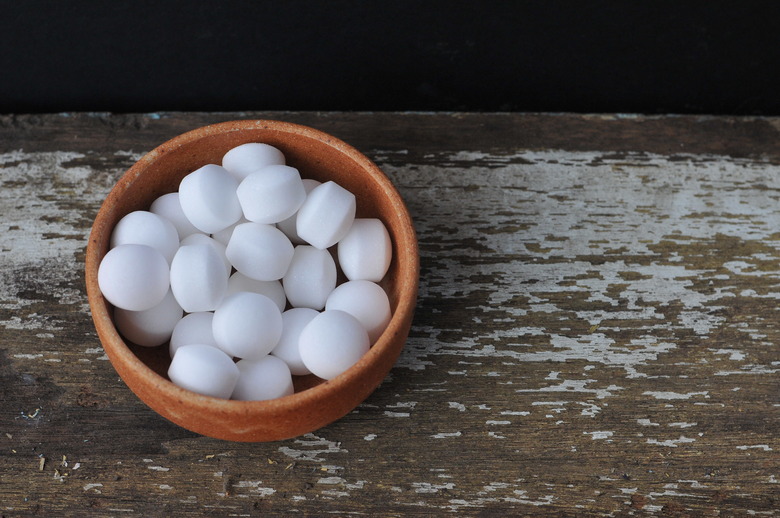How To Get Rid Of Mothball Smell
Mothballs control clothes-eating moths, but some people use them to control other pests, including rodents, snakes and other insects. One end result is a lingering odor that's as bad for you as it smells due to the pesticides used in mothballs. There's no magic bullet for neutralizing mothball odor. The best strategy is to turn up the heat, provide plenty of ventilation and wait, but some other options may help speed up the process
Mothball Ingredients
Mothball Ingredients
The traditional ingredient in mothballs is naphthalene, a compound that can cause serious health problems, especially for children. More recent mothball formulations replace naphthalene with paradichlorobenzene, a slightly less toxic compound, but one that can still cause dizziness and nausea.
Both chemicals, which are possible carcinogens, enter the air through sublimation. In other words, mothballs change from a solid to a vapor state without becoming a liquid. If you can pick up the characteristic mothball smell, it means that solid pieces are in the vicinity, although they might be too small to see. You need to eliminate these pieces to be rid of the odor.
Removing Mothball Smell From Clothes
Removing Mothball Smell From Clothes
You can easily toss clothes in the washing machine, but what do you do if the mothball smell doesn't go away completely? One option is to soak the stinky clothes in one one part water and one part vinegar. If you prefer to use your washing machine, run the clothes through a cycle using vinegar instead of detergent with another wash cycle following that uses detergent.
Hold off on drying your clothes until you're sure the mothball smell is gone. Heat can set stains and smells in clothing, so the mothball odor can be even more difficult to remove if you put the stinky clothes in the dryer.
Clean the Floor and Walls
Clean the Floor and Walls
When a room has a persistent mothball odor, the first step to eliminating it is to thoroughly clean the area to get rid of any solid particles. Wear gloves and a respirator while doing this to protect yourself from the chemicals. Vacuum the floor and empty the bag outside. Then wash the walls and woodwork with a mild detergent solution.
If the residue is minor, a thorough cleaning may take care of the problem, but if the odor lingers, it's often because small particles have lodged in the pores of unfinished wood, in furniture fabrics, carpets and clothing. Clothing can be laundered, but removing particles from upholstery and carpeting isn't as easy.
Heat and Ventilation
Heat and Ventilation
The best method of removing mothball odor from the house that's coming from furniture is to provide heat to increase the rate of sublimation and also provide plenty of ventilation. If you can, move affected furniture outside and leave it in a sunny place for several days.
Furniture that's too large to take outside should at least be moved close to a window with a strategically placed fan blowing smell outside. If it's impractical to raise the temperature in the room or use a space heater, you'll have to wait longer for the solids to sublimate and the smell to dissipate.
Odor-Absorbing Materials
Odor-Absorbing Materials
Another option is using other materials that help absorb odors. Mothball odor eliminator options include activated charcoal, which comes in pellets, and coffee grounds. Put a container of the odor-absorbing substance in the area until the smell is completely gone. You may need to toss the materials and put fresh material in the space to completely get rid of the smell.
Deep Cleaning
Deep Cleaning
Mothballs in drawers or closets can crumble, leaving small particles in the pores of the wood. If cleaning doesn't remove all of these, you may have to seal the wood with varnish or paint to get rid of the odor. Running an ozone generator may help, but keep in mind that ozone is a pollutant and can create another, more serious, odor problem.
Mothball Alternatives
Mothball Alternatives
To avoid mothball odors in the future, consider using alternatives, including cedar chips, eucalyptus leaves, peppercorns, lavender, cinnamon sticks or rosemary. You can make your own sachets with your choice of these materials placed inside a cheesecloth bag or similar breathable material.
You can also minimize the risk of moths by using good storage options. If you store clothes in containers when you put them away from the season, make sure those containers are clean with no risk of moth eggs waiting inside. Instead of plastic tubs or other containers moths can get into easily, consider vacuum storage bags. It's also a good idea to thoroughly wash clothes before storing them to cut down on odors that might attract moths.
References
- InspectAPedia: Moth Pests and Mothball Odor Hazards and Best Methods for Removal of Mothball Odors
- National Pesticide Information Center: Paradichlorobenzene
- National Pesticide Information Center: Naphthalene
- InspectAPedia: Use of Ozone Generators Indoors for Control of Odors and Mold Removal in Buildings
- Rainbow International Restoration: How to Remove Mothball Odor
- Department of Health and Hospitals: What You Should Know About Mothballs
